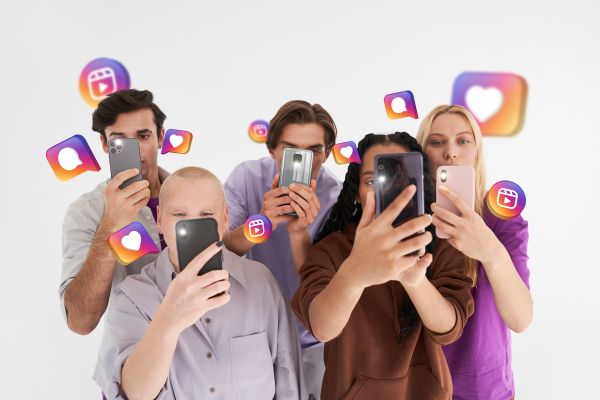Staying ahead of influencer marketing trends for 2025 is more important than ever for brands that want to remain competitive and relevant. As influencer marketing continues to grow, 76% of C-suite executives plan to increase their influencer budgets in 2025 – a clear signal that this channel is becoming a core part of modern marketing strategies.
But what exactly do we mean by “influencer marketing trends”? These trends reflect the emerging shifts in platforms, audience behavior, technology, and influencer collaboration models that will shape how brands and creators connect next year and beyond.
In this article, we’ll break down the most important trends to watch, explain why they matter, and share actionable insights to help business owners and marketers adjust their strategies for better engagement, visibility, and ROI, all in an easy-to-follow, practical way.

Top Influencer Marketing Trends to Watch in 2025
The influencer marketing landscape is evolving quickly, and 2025 will bring new opportunities and new challenges for brands and creators alike. Below, we highlight the key trends that are set to shape the industry, along with insights on how brands can adapt to stay ahead and drive stronger results.
#1 Rise of Micro and Nano-Influencers (and Hyperlocal Campaigns)
One of the defining influencer marketing trends for 2025 is the rise of micro and nano-influencers, creators with smaller but highly engaged audiences. Brands are increasingly shifting their focus toward these influencers because they offer something that’s becoming harder to find: authentic, trusted connections with niche communities.
Micro-influencers (typically 10K–100K followers) and nano-influencers (1K–10K followers) often maintain closer relationships with their audiences. Their recommendations feel more personal and less like traditional advertising, which leads to higher engagement rates, stronger trust, and better conversion rates compared to large celebrity partnerships.
Another emerging aspect of this trend is the hyperlocal focus. Brands are no longer just thinking nationally or globally, they’re running hyperlocal influencer campaigns, working with local creators to connect authentically with regional audiences. By tapping into community conversations, businesses appear more relatable, culturally relevant, and trustworthy to potential customers in specific areas.
Why it matters:
- Better ROI: Micro and nano-influencers generally cost less to partner with but deliver higher engagement and conversion rates.
- Genuine connections: Audiences trust smaller creators more, making their endorsements feel authentic and persuasive.
- Stronger community presence: Hyperlocal campaigns allow brands to build real loyalty and relevance within targeted regions.
Actionable tip:
Consider reallocating part of your influencer marketing budget to work with several micro- and nano-influencers rather than investing heavily in a single large creator. Focus on influencers whose audience demographics, location, and values closely align with your brand.
Understand who social media influencers are and how they work in our complete guide: What is a Social Media Influencer? Complete Guide & Tips
#2 B2B and LinkedIn Influencer Marketing Expands
One of the most surprising influencer marketing trends for 2025 is the rapid growth of B2B influencer marketing, particularly on LinkedIn. Influencer marketing is no longer limited to fashion, beauty, or lifestyle brands – even buttoned-up B2B industries are getting in on the action.
On LinkedIn, executives, industry experts, and thought leaders are becoming key influencers, driving conversations that matter to professional audiences.
Brands targeting professionals are increasingly collaborating with these LinkedIn influencers to boost brand credibility, build trust, and spark meaningful engagement within specific industries. These partnerships feel natural because audiences view these influencers as peers and experts rather than traditional advertisers.
Adding to this momentum, LinkedIn’s surge in video content is playing a major role. According to Forbes Agency Council, the rise of LinkedIn Video is one of the standout trends for 2025. Influencers are leveraging short videos, live sessions, and educational clips to build deeper relationships with their networks, making LinkedIn a dynamic platform for B2B brand storytelling.
Why it matters:
- Stronger professional trust: Recommendations from respected experts resonate more with B2B buyers than traditional ads.
- Higher engagement: LinkedIn posts by influencers, especially video content, are seeing growing engagement rates as audiences crave authentic, expert-driven insights.
- Competitive advantage: Early adopters of LinkedIn influencer partnerships can position themselves ahead of slower-moving competitors in their industry.
Actionable tip:
If you’re targeting business audiences, consider adding LinkedIn influencers, or even employee advocates, as a formal part of your marketing strategy. Focus on collaborating with professionals who already have a voice in your target industry, and encourage video content for higher visibility and impact.
#3 Multi-Platform Campaigns and Cross-Channel Presence
Another major influencer marketing trend for 2025 is the shift toward multi-platform campaigns and cross-channel presence. Gone are the days when influencer marketing meant a single Instagram post or a one-off YouTube video. Today’s most successful influencer marketing strategies for 2025 are designed to span multiple platforms, maximizing reach, engagement, and impact across diverse audiences.
For example, a campaign might kick off with a viral TikTok video to spark buzz, continue with a series of Instagram Stories and Reels to deepen engagement, and extend the conversation on X/Twitter or even LinkedIn for professional visibility.
Each platform plays a unique role in the customer journey:
- TikTok: Captures virality and quick attention.
- Instagram: Builds community and visual brand loyalty.
- YouTube: Provides long-form storytelling and product education.
- LinkedIn: Strengthens thought leadership and professional credibility.
The key for brands is to adapt content for each platform’s strengths while maintaining a consistent brand message across all channels.
Why it matters:
- Greater audience reach: Not all customers live on one platform; cross-channel campaigns meet audiences where they are.
- Stronger brand reinforcement: Repetition across platforms builds familiarity and trust faster.
- More data points: Multi-platform strategies give brands more opportunities to track and optimize performance across different audience segments.
Actionable tip:
Audit your current influencer marketing efforts: Are you still relying on just one platform? In 2025, aim to integrate at least two (or more) platforms into each influencer campaign. Tailor the content format to fit each platform while keeping your overall campaign messaging unified for a bigger, more lasting impact.

#4 AI-Powered Influencer Marketing Tools
AI is no longer a buzzword in influencer marketing, it’s now a core part of how top brands plan, execute, and optimize their campaigns. In 2025, AI-powered tools are taking center stage by automating influencer discovery, predicting campaign outcomes, analyzing audience sentiment, and even suggesting the best posting times or creative formats based on performance trends.
Platforms like Hypefy, Influencity, and Tagger are integrating machine learning to help marketers make faster, data-driven decisions. These tools can identify which creators align best with your brand, estimate the ROI of a campaign before it launches, and deliver performance reports in real time, saving teams hours of manual effort.
Some AI platforms even use image and language recognition to analyze influencer content beyond the surface, detecting tone, sentiment, and brand safety risks before a partnership begins.
Why it matters:
- Smarter influencer selection: AI helps identify creators whose content, audience, and performance match your goals more precisely.
- Faster campaign optimization: Real-time insights and automated recommendations make it easier to tweak live campaigns.
- Increased efficiency: AI tools reduce time spent on manual research, reporting, and coordination.
Actionable tip:
In 2025, invest in at least one AI-powered influencer platform to streamline your marketing workflow. Use it to compare influencer performance across platforms, evaluate historical engagement patterns, and forecast expected ROI, especially useful for brands scaling globally or managing multiple influencer campaigns at once.
#5 Demand for Authentic, Purpose-Driven Content
Among influencer marketing trends for 2025, an emphasis on authenticity clearly stands out. Both social media algorithms and users, especially Gen Z, are prioritizing genuine, purpose-driven content over polished, overly branded promotions. Audiences are looking for creators and brands that stand for something meaningful, not just push products.
As Forbes highlights, “Authenticity over everything: Gen Z demands brands with purpose, not just products.” In 2025, influencers who share personal values, advocate for social causes, and present their real selves will continue to outperform those who rely on scripted, salesy content.
This trend is manifesting in several key ways:
- Social cause campaigns: More brands are partnering with influencers to highlight sustainability, mental health awareness, DEI (diversity, equity, inclusion), and other important movements.
- Behind-the-scenes stories: Audiences love real-life glimpses into the creator’s process, struggles, and everyday life.
- Real testimonials over polished ads: Genuine reviews, personal experiences, and unfiltered opinions resonate far more than overly produced content.
There’s even a rising mini-trend called deinfluencing, where audiences call out inauthentic promotions and advise others on what not to buy. This movement further pressures brands and influencers to be transparent, truthful, and intentional in their partnerships.
Why it matters:
- Stronger trust: Authentic content builds real, lasting trust between brands, influencers, and audiences.
- Better engagement: Genuine storytelling encourages more meaningful conversations, shares, and loyalty.
- Long-term brand equity: Aligning with purpose-driven influencers strengthens brand reputation over time.
Actionable tip:
When selecting influencers in 2025, look beyond follower count. Vet potential partners for authenticity by reviewing their past collaborations, how they engage with their audience, and whether their personal values align with your brand. Don’t be afraid to co-create content that shows personality, real stories, and shared purpose, it’s exactly what modern audiences are craving.
#6 Social Commerce and Shoppable Content
Among 2025’s influencer marketing trends, the boom in social commerce is a true game-changer for brands looking to boost online sales. The line between social media and shopping continues to blur, and influencers are at the center of this transformation, making it easier than ever for followers to go from inspiration to purchase in just one click.
Platforms like TikTok, Instagram, Pinterest, and YouTube have all expanded their e-commerce features:
- TikTok Shop and live shopping events let users buy products directly through videos and livestreams without leaving the app.
- Instagram allows influencers to tag products in posts and Stories, while brands can set up full storefronts.
- Pinterest offers product Pins and Shopping Ads, helping influencers inspire purchases through curated boards.
- YouTube has integrated product tagging and shopping shelves under videos, letting creators drive sales directly from their content.
According to TikTok’s own data, 78% of TikTok users have discovered products through influencer content, showing just how powerful social commerce has become for product discovery and purchasing.
Why it matters:
- Shorter sales funnel: Followers can move from inspiration to checkout seamlessly, reducing friction and boosting conversions.
- Increased impulse buying: Real-time product demos, reviews, and recommendations drive faster purchase decisions.
- Measurable ROI: Brands can directly track how influencer content impacts sales through platform-native shopping tools.
Actionable tip:
In 2025, make sure your products are fully integrated into social shopping features on TikTok, Instagram, Pinterest, and YouTube. When selecting influencers, prioritize those who are skilled at live product demos, authentic reviews, and interactive selling skills that are critical for driving sales through social commerce.

#7 Long-Term Partnerships Over One-Off Deals
Another key influencer marketing trend for 2025 is the shift from one-off sponsored posts to long-term influencer partnerships and brand ambassador programs. Instead of hiring influencers for a single ad, brands are now building ongoing relationships, where influencers create a series of authentic content over months or even years.
Why the shift?
Long-term collaborations foster deeper trust with audiences. When an influencer consistently features a product or service over time, followers view the endorsement as genuine, not just another paid promotion.
Plus, long-term partnerships allow influencers to naturally integrate your product into their lifestyle, telling richer, more believable stories that resonate with audiences.
Brands like Gymshark and HelloFresh have built highly successful long-term influencer programs, turning trusted creators into recognizable faces for their brands, and seeing loyalty, customer trust, and conversions rise as a result.
Why it matters:
- Stronger credibility: Ongoing partnerships feel authentic and less transactional.
- Better ROI: Investing in long-term relationships often delivers more value than running multiple one-off campaigns with different influencers.
- Deeper brand integration: Influencers become true advocates who can speak more knowledgeably and personally about your brand.
Actionable tip:
Think of influencers as extensions of your team. Identify a few key creators whose values align closely with your brand. Offer multi-month contracts, affiliate partnerships, or even collaborative product lines to strengthen the relationship. Set clear deliverables upfront (e.g., monthly posts, seasonal promotions, exclusive discounts) while leaving room for the influencer’s creative input to keep content feeling fresh and authentic.
#8 Improved Measurement and ROI Focus
As influencer marketing trends in 2025 shift toward greater accountability, brands are adopting better ROI measurement practices to ensure their campaigns deliver real business value, not just vanity metrics. While measuring influencer impact has traditionally been a challenge, the industry is making significant strides toward unified, holistic measurement that tracks results across the entire funnel.
Explore how to measure success with our guide on Influencer Marketing ROI.
Key developments driving this trend:
- Advanced analytics tools: New influencer marketing platforms and social media insights now allow brands to track not just reach and engagement, but also conversions, website traffic, and direct revenue from influencer-driven campaigns.
- Value over vanity: Marketers are moving beyond likes and shares to focus on meaningful KPIs, such as purchases, sign-ups, or lead generation, providing a clearer picture of true ROI.
- Cross-platform attribution: Brands are combining data from multiple platforms into centralized dashboards, allowing for easier, more accurate campaign analysis.
Why it matters:
- Better budget allocation: Brands can optimize spend based on real results, investing more in top-performing influencers and tactics.
- Stronger justification: Accurate ROI measurement helps marketers justify influencer budgets to stakeholders and leadership teams.
- Smarter strategy adjustments: Real-time insights allow for faster course corrections and better long-term planning.
Actionable tip:
Set clear campaign goals upfront, whether it’s raising brand awareness, driving traffic, or boosting sales, and choose KPIs that match those goals. Use tools like affiliate links, promo codes, custom landing pages, or advanced UTM tracking to properly attribute results to specific influencers.
Consider adopting influencer marketing platforms that offer analytics dashboards, helping you consolidate performance data across channels for easier reporting and smarter decision-making.
Encouragement: Measuring influencer marketing ROI can feel overwhelming at first, but with the right structure and tools, you can finally quantify the buzz and confidently show the true impact of your campaigns.
#9 Short-Form Video Content Reigns Supreme
Short-form video continues to dominate influencer content strategies across nearly every major platform. With shrinking attention spans and the rise of mobile-first browsing, brands and creators are leaning heavily into formats like TikTok videos, Instagram Reels, and YouTube Shorts to engage audiences quickly and effectively.
These bite-sized videos allow influencers to tell compelling stories, showcase products, and deliver brand messages in under 60 seconds, perfect for today’s scroll-happy users. Whether it’s a quick tutorial, product review, day-in-the-life snippet, or trend-based content, short-form video strikes the balance between entertainment and information.
More importantly, social platforms are doubling down on promoting this format. TikTok remains a leader, while Instagram’s algorithm now favors Reels over static posts, and YouTube Shorts continues to gain traction, especially among Gen Z viewers.
Why it matters:
- Higher engagement rates: Short-form videos consistently outperform static content and long-form formats in likes, shares, and comments.
- Platform priority: Social algorithms now favor short-form videos, giving creators and brands better organic reach.
- Fast content turnaround: These videos require less production time and can be created quickly to jump on trending sounds and challenges.
Actionable tip:
In 2025, make short-form video a core part of your influencer strategy. Provide creators with flexible creative briefs that allow for trend participation, quick product showcases, or behind-the-scenes glimpses, and encourage them to use native tools (like music, effects, and captions) to maximize reach and relatability.

#10 Sustainability Takes Center Stage
Sustainability is no longer a niche talking point, it’s becoming a central pillar of influencer marketing campaigns in 2025. As climate concerns grow and conscious consumerism becomes mainstream, audiences are actively seeking out brands and influencers that reflect environmentally responsible values.
Influencers who speak authentically about sustainability, whether it’s slow fashion, ethical sourcing, clean ingredients, or low-waste lifestyles, are gaining traction across platforms. Brands that partner with these creators can boost credibility, strengthen consumer trust, and align with the values of younger generations like Gen Z and Gen Alpha.
Even mega-influencers and celebrities are now promoting sustainable alternatives, while micro-influencers in this space are building passionate communities around mindful consumption, circular fashion, and green beauty.
Why it matters:
- Brand differentiation: Sustainability-driven partnerships can set your brand apart in crowded markets.
- Deeper loyalty: Consumers are more likely to stay loyal to brands that reflect their environmental and ethical values.
- Press and PR value: Campaigns with strong sustainability narratives often gain media attention and social sharing.
Actionable tip:
Audit your current influencer marketing strategy for sustainability opportunities. Whether it’s collaborating with creators in the eco-space, co-creating content around green initiatives, or highlighting sustainable product features, make sure your campaigns reflect real, transparent commitments, not just buzzwords. Authenticity is key.
#11 Rise of Virtual Influencers
One of the most futuristic, and fast-growing influencer marketing trends of 2025 is the rise of virtual influencers. These CGI or AI-generated personalities aren’t just digital gimmicks anymore; they’re attracting real audiences, signing brand deals, and even appearing in fashion shows, music videos, and ad campaigns.
Notable examples like Lil Miquela, Imma, and Noonoouri have proven that followers don’t always need a “real” human face to feel the connection. With consistent branding, 24/7 availability, and zero risk of PR scandals, virtual influencers offer brands more control and creative freedom than ever before.
What’s more, advancements in generative AI mean virtual influencers can now post “live” content, interact with fans via AI chatbots, and collaborate with real influencers in hybrid campaigns.
Why it matters:
- Total brand control: Virtual influencers allow brands to fully script the personality, tone, and messaging of the influencer.
- Innovation edge: These campaigns stand out, drawing curiosity, media attention, and early adopter engagement.
- Future scalability: Brands can scale virtual campaigns across regions without relying on human limitations like scheduling or geography.
Actionable tip:
Test a low-risk collaboration with a virtual influencer in 2025. Start with an awareness campaign where creative control matters most, like a product launch or brand activation. For extra engagement, pair a virtual influencer with a real creator for a hybrid campaign that merges novelty with authenticity.
To Summarize: Stay Ahead of 2025’s Influencer Marketing Trends
Influencer marketing is evolving faster than ever, and brands that stay flexible, embrace new technologies, and prioritize authenticity will thrive in 2025 and beyond. By adapting your strategies to the latest trends, you’ll not only reach your target audiences more effectively, but you’ll also build real connections that turn followers into loyal customers.
Ready to future-proof your influencer marketing strategy? Discover how Hypefy’s Influencer Marketplace and AI-powered tools can help you find, hire, and manage top creators across every platform, all in one place.



